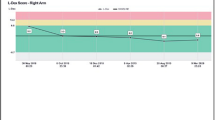Abstract
Purpose of Review
To review the literature regarding the pathophysiological changes found in BCRL and to link them to the cancer and the type and sequencing of treatments and raise attention to the fact that not all parts of the arm at risk or with lymphoedema may have underlying changes which are similar or are progressing at the same rate.
Recent Findings
There still remains a lack of awareness regarding BCRL-related pathophysiology and of the range of reasons for it. Linked to this is a lack of appropriate in-clinic assessment of these changes and of the use of this information to better target and sequence treatment. We are refining and improving our consensus documents related to lymphoedema and the impact of the pathophysiology on its staging which will help in this.
Summary
We should link the pathophysiological changes we find and record with the functional changes which are signs of that underlying structural change through increased use of a range of assessment tools such as indurometry, bio-impedance spectroscopy, tissue dielectric constants, ICG, lympho-scintigraphy, etc. We must better target and sequence our treatments and relate them to our measures of pathophysiological and functional changes.
Similar content being viewed by others
References
Papers of particular interest, published recently, have been highlighted as: • Of importance •• Of major importance
Brouillard P, Boon L, Vikkula M. Genetics of lymphatic anomalies. J Clin Invest. 2014;124(3):898–904. https://doi.org/10.1172/JCI71614.
Ho B, Gordon K, Mortimer. A genetic approach to the classification of primary lymphoedema and lymphatic malformations. Eur J Vasc Endovasc Surg. 2018;56(4):465–6. https://doi.org/10.1016/j.ejvs.2018.07.001.
Foeldi M, Foeldi E. Lymphostatic diseases chapter 3 176–250 In: Foldi’s textbook of lymphology for physicians and lymphoedema therapists. Foeldi M and Foeldi E, editors. Elsevier, Urban and Fisher Munich; 2012.
Kaiserling E. Morphological findings in lymphoedema and tumours chapter 4 262–315 In: Foldi’s textbook of Lymphology for physicians and Lymphoedema therapists. Foeldi M, Foeldi E, editors. Elsevier, Urban and Fisher Munich; 2012.
Foeldi E. Pathophysiology of secondary lymphoedema. Chapter 13 189–194. In: Lymphoedema complete medical and surgical management Neligan P, Masia J, Piller N, Editors. CRC Press; 2016.
Witte M. A Curriculum on Medical Ignorance. 2013. https://www.youtube.com/watch?v=u3SGNvMcNdI.
Rockson S. Lymphatic medicine: paradoxically and unnecessarily ignored lymphatic research and biology. 2017;15(4):315–316.
Vuong D, Nguyen M, Piller N. Medical education: a deficiency or a disgrace. J Lymphol. 2011;6(1):44–9.
International Society of Lymphology. The diagnosis and treatment of peripheral Lymphoedema −2020 consensus document lymphology. Lymphology. 2020;53(1):1–10.
Douglass J, Kelly-Hope L. Comparison of staging systems to assess lymphoedema caused by cancer therapies, lymphatic filariasis and podoconiosis. Lymphat Res Biol. 2019;17:1–7. https://doi.org/10.1089/lrb.2018.0063.
Li C, Kataru R, Mehrara B. Histopathologic features of lymphedema: a molecular review. Int J Mol Sci. 2020;21(7):E2546. https://doi.org/10.3390/ijms21072546.
Azhar S, Lim H, Tan B, Angeli V. The unresolved pathophysiology of lymphedema. Front Physiol. 2020;11:137. https://doi.org/10.3389/fphys.2020.00137.
Piller N, Keeley V, Ryan T, Hayes S, Ridner S. Early detection – a strategy to reduce risk and severity. J Lymphoedema. 2009;4(1):11–6.
Piller N. Pro-active treatment for lymphoedema needed for lymphoedema patients. J Lymphoedema. 2011;6(1):2.
Piller N. Decisions: they are never easy! This is what we would like to do and here are the reasons why. J Lymphoedema. 2018;13(1):5–8.
Ryans K, Davies C, Gaw G, Lambe CM, Henninge M, van Hoose L. Incidence and predictors of axillary web syndrome and its association with lymphedema in women following breast cancer treatment: a retrospective study. Support Care Cancer. 2020. https://doi.org/10.1007/s00520-020-05424-x.
Leduc O, Fumiere E, Banse S, et al. Identification and description of axillary web syndrome (AWS) by clinical signs, MRI and US imaging. Lymphology. 2014;47(4):164–76.
Koehler L, Hunter D. The axillary web and its lymphatic origin. Lymphology. 2016;49(4):185–91.
Hunt C, Kamyab R. Axillary web syndrome: a case presenting during neo-adjuvant chemo- therapy for breast cancer. J Lymphoedema. 2018;13(1):16–9.
Douglass J, Graves P, Gordon S. Intra-rater reliability of tonometry and bio-impedance spectroscopy to measure tissue compressibility and extra-cellular fluid in the legs of healthy young people. Lymphat Res Biol. 2017;15(1):57–63. https://doi.org/10.1089/lrb.2016.0021.
Suami H, Heydon-White A, Mackie H, Czerniec S, Koelmeyer L, and Boyages J. A new indocyanine green fluorescence lymphography protocol for identification of lymphatic drainage pathway for patients with breast cancer related lymphoedemas. BMC Cancer 2019
Brandon Dixon J, Weiler M. Bridging the divide between pathogenesis and detection in lymphedema. Semin Cell Dev Biol. 2015;38:75–82.
Acknowledgments
This article is very different from what I set out to write about the pathophysiology of BCRL. Why? Well, our daughter (Chantelle O’Brien) at the age of 37 is currently undergoing the treatment programmes for her recently diagnosed BC. Talking with her about it, it soon become clear that I needed to try to look more holistically at the pathophysiological focus and link them more clearly with changes in the limb specifically linked to the issues of cancer and its infiltration impact and those of the treatments and their sequencing and then on what may occur in the follow-up stages of lymphatic disruption. I’m not sure if I have totally captured this intent, but I hope it will persuade others to think about the bigger picture, the cancer treatments and their sequencing, the patient at the centre of these, and the issues of pathophysiological progression and its treatment on patient functionality and of the measurements we can use to indicate approaching return to normalcy instead of continuing pathophysiological progression.
Author information
Authors and Affiliations
Corresponding author
Ethics declarations
Conflict of Interest
Neil Piller declares no conflicts of interest relevant to this manuscript.
Human and Animal Rights and Informed Consent
This article does not contain any studies with human or animal subjects performed by any of the authors.
Additional information
Publisher’s Note
Springer Nature remains neutral with regard to jurisdictional claims in published maps and institutional affiliations.
This article is part of the Topical Collection on Lymphedema Incidence, Prevention and Treatment
Electronic supplementary material
ESM 1
(DOCX 33 kb)
Rights and permissions
About this article
Cite this article
Piller, N.B. Pathophysiology of Breast Cancer-Related Lymphoedema. Curr Breast Cancer Rep 12, 225–229 (2020). https://doi.org/10.1007/s12609-020-00377-w
Published:
Issue Date:
DOI: https://doi.org/10.1007/s12609-020-00377-w




